Korfball drills for technique attack / score
Play with 4 players around the post.
- 1 player grabs the catch.
- Next player to pass the ball, takes the hand-off.
- Ball is played in to the handler, handler passes back out to the person from whom he/she got the ball.
- Player takes a shot.
Important is to keep high ball tempo, fill in fast, fill in correct persons and throw correct hand.
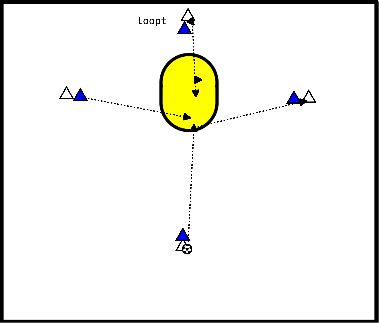
We play 4:4, with 3 attackers playing in the service of 1 striker.
- The goal of the exercise is to free the striker in such a way that she will score. This can be done in many ways, but see what her defender's weakness is and play that out.
- You can also take advantage of the attacker's real quality.
- Shooter at 6 yards always free after a breakthrough. Coming from deep after a shot from another.
- Each attacker gets a turn.
As a quieter exercise in between:
- 2-tal shoot under the post until the 11
- then the 11 again and back to 0.
To make it more difficult you can subtract 1 per miss or per time the ball falls to the ground.
By 3 at a basket.
Step 1:
Step 1:
- Player Red defends Player Blue.
- Player Blue has the ball and then throws it to Player White and runs deep and shoots.
Step 2:
- Follow Step 1 and after Player Blue runs deep, Player White rushes in for a giveaway.
- Player Blue goes for a pass through Blue.
- Player Red continues to defend, but allows the through ball.
Take the goal attempts as calmly as possible
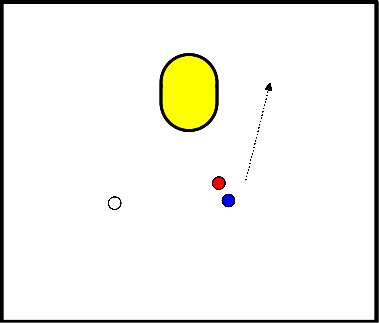
Circuit training where one station is rotated through every 2 minutes.
Possibly adjust assignments to number of players.
At each station, shoot from a different spot to score. Per 2-team.
Examples for distances:
Possibly adjust assignments to number of players.
At each station, shoot from a different spot to score. Per 2-team.
Examples for distances:
- 2.5 meters in front of the post.
- 2.5 meters behind the post.
- Distance shot.
- Side shots.
- Top-handed through-balls.
- Underhanded through-balls.
- Player A starts with the ball 2.5 meters diagonally in front of the post. Player B also stands 2.5 meters diagonally in front of the post.
- Player A throws the ball to player B and player B throws it back. Thus they bring the ball up to about 8 meters in front of the post.
- From there, player B starts for a through ball from the space indicated by player A.
- However, instead of player B taking the through ball, it now enters the declarer and player A comes in for a clearance ball. Player B catches the ball.
A variation on this:
Only throw the ball when player B runs next to/behind the basket and player B immediately makes a shot. Player A immediately runs in to catch the ball.
Only throw the ball when player B runs next to/behind the basket and player B immediately makes a shot. Player A immediately runs in to catch the ball.
There are more variations on this, such as:
- Most goals in a time frame of, say, 10 minutes
- Who scores 10 goals first
- Make it more difficult by deducting a point for each ball on the ground.
- Possibly with a 3rd player to rotate and keep a slightly slower pace.
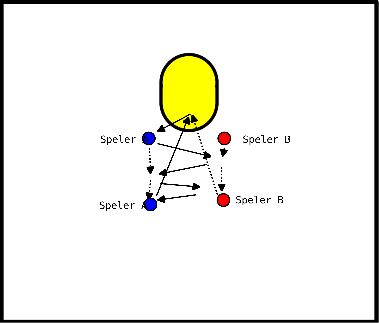
- Player A starts with the ball 2.5 meters diagonally in front of the post.
- Player B also stands 2.5 meters diagonally in front of the post.
- Player A throws the ball to player B and player B throws it back.
- Thus they bring the ball up to about 8 meters in front of the post.
- From there player B starts for a through ball from the space indicated by player A.
- Player A also runs in after it to catch the ball before it bounces on the ground.
Variations:
- Most goals in a 10-minute time frame.
- Whoever gets to 10 goals first.
- Make it harder by taking a point off every ball on the ground.
- Possibly with a 3rd person there to rotate through and keep a slightly slower pace.
- Most goals in a 10-minute time frame.
- Whoever gets to 10 goals first.
- Make it harder by taking a point off every ball on the ground.
- Possibly with a 3rd person there to rotate through and keep a slightly slower pace.
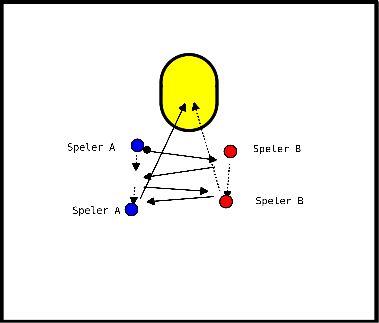
- Per person, everyone must score 10 through balls, this goes in groups of 3 or 4.
- In case of a miss, the whole group goes to the other side of the field on pace run and back.
- The one who missed takes the chance again.
- Until 10 are scored per player.
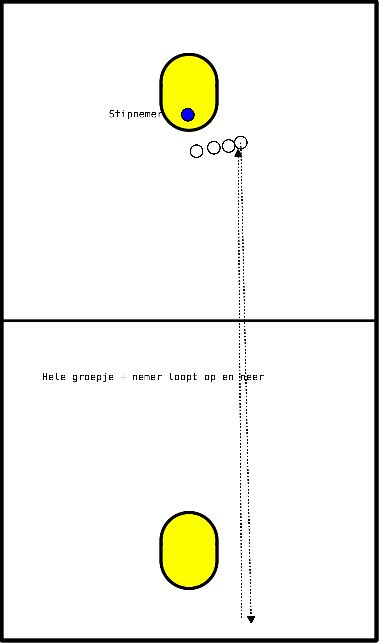
Goal: defend your own basket but score at another. Whoever remains last wins.
Minimum 3 groups of 2.
Maximum 5 groups of 3 or 4 groups of 4.
Minimum 3 groups of 2.
Maximum 5 groups of 3 or 4 groups of 4.
- Each group has a basket.
- Number of balls depends on how many groups. For example, 3 groups 2 balls.
- Make easier by fewer balls and larger groups.
- the back player cuts in to the support as the ball enters the field and gets it played.
- the passer simultaneously runs across the support to the rebound and takes over.
- the support passes the ball to the diagonal player in the break and takes the shot
- If that is not successful, the ball can be passed to the outgoing first rebounder
At that point, there can be doubles/ breakthroughs from both the first and second players and you get opportunities again if the then standing rebounder steps out again or the earlier support makes an action without the ball.
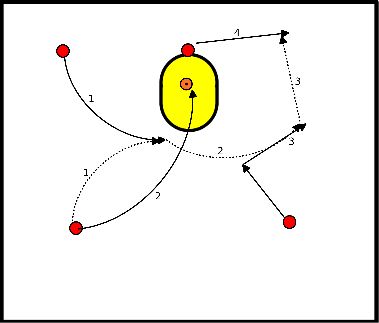
- The first ball is played deep from the front pocket.
- Then the other front comes in and passes the ball.
- The first passer runs across the block to the catch.
- The adjuster runs on the ball side for a through ball to the post.
Alternatively, the ball is played back directly for the distance shot. - The player under the post steps out as soon as the rebound is taken over from the front and ensures that the player with the ball has two points of attack.
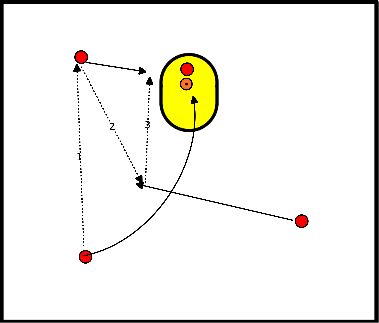
- This exercise is designed to let the players choose for themselves what they want to improve on.
- Which (improvement) goal, which they have set for themselves, do they want to improve here.
- As a trainer you can steer this by guiding the choice.
- For example: the exercise must have something to do with passing/shooting/attacking/looking etc.







